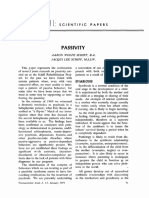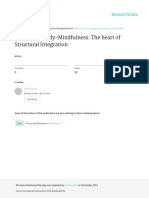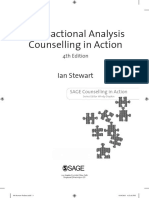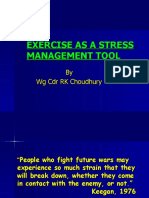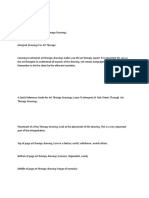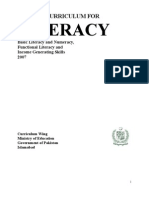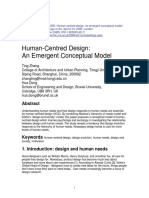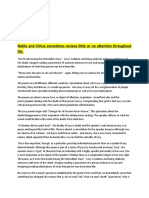Ta
Ta
Uploaded by
wonder_full77Original Description:
Original Title
Copyright
Available Formats
Share this document
Did you find this document useful?
Is this content inappropriate?
Report this DocumentCopyright:
Available Formats
Ta
Ta
Uploaded by
wonder_full77Copyright:
Available Formats
FREE EBook Volume 5 Life Lessons
Transactional Analysis and Life Scripting in Relationships and Communication
Author
Suzanne Tabor
TRANSACTIONAL ANALYSIS AND LIFE SCRIPTING The purpose of writing an article on Transactional Analysis (TA) and Life Scripts on a Kinesiology website is to provide alternate and perhaps to the reader, new dimension to understanding aspects that affect our relationships and communication with others regardless of whether that other, is family and friends; associates; or, clients. All interactions/communications are affected by our previous experiences, and by the constructed and inherited belief systems through which we perceive the world, and the worlds relationship with us. Importantly, in addition to assisting with interacting with others in general, as Practitioners, it is helpful to be able to recognise the scripting and ego state interactions that are occurring in the Clinic/client context. There are various forms of assessing human behaviour, and it is not the intention of this article to delve deeply into the psychology or psychiatry fields but rather to give a general overview of some of the approaches, such as Transactional analysis and Scripting, in laymans terms for consideration. Gestalt Therapy:- Dr Frederick Pearls, a Freudian analyst, used Gestalt psychology to develop gestalt therapy. Gestalt is a German word which means organised whole. Although the approach is different, Gestalt therapy, like Kinesiology, focuses on helping/facilitating the person becoming Whole The aim of Gestalt Therapy is to help people become whole to help them become aware of, and admit to, reclaim, and integrate their fragmented parts. Integration helps a person make the transition from dependency to self sufficiency, from authoritarian outer support to authentic inner support. Gestalt Therapy concentrates on role playing, exaggerating symptoms or behaviour, to experience the situation and to gain more understanding of the situation and the emotions and bodily sensations involved at the time. In Gestalt Therapy the emotional and intellectual insight is gained through the process, with the focus more on the emotional awareness. A Kinesiology comparison would be ESR Past /Future. Gestalt Therapy focuses on the construct of winners and loses. It was the paradigm on which much of the personal development and business management programs were based in the 70s and 80s, and is still deeply rooted in many management and professional belief systems still today. James and Jongeward (1978) proposed that A winner is one who responds authentically by being credible, trustworthy, responsive, and genuine, both as an individual and as a member of society. A loser is one who fails to respond authentically. Perhaps more relevant to Kinesiology, and particularly in terms of client history as it pertains to the session context is Berne, James and Jongewards concepts of Transactional Analysis:- Eric Berne developed Transactional Analysis (TA) focusing on both the emotional and intellectual insight, but primarily on the intellectual lessons to be learnt. He theorized that a persons interactions with other people were based in three observable transactions ego states that of a Child, a Parent, or an Adult. Additionally he say that some of these transactions had
ulterior motives, involved manipulating others through psychological games, or indeed were as though being acted out on a stage, performing to some predetermined script, hence the Ego States and Script Analysis identified in his Transactional Analysis. The Child Ego State is the inner world of feeling, adaptations and experiences, it accesses the permanent recordings in the brain and nervous system of the childhood impulses, how we viewed the world, experienced the world and felt about it, and how we adapted. Parent Ego State Each parent has three unique ego states within their own parent ego state incorporating his/her own parents adult, parent and child ego state, which incorporates the grandparents adult/parent and child ego states also. The Parent ego state contains within it the personalities of emotionally significant authorities from both childhood and adulthood. It needs to be noted that an individual does not necessarily need to be a parent to transact from the parent ego state, but rather to take a parenting perspective or attitude towards another with whom they are transacting. Adult Ego State Ideally as adults, we transact from our adult ego state, regardless of the age or relationship of the person with whom we are communicating. The adult ego state is mature, it is influenced by intelligent responses to experiences and is objective in its observations. Through self awareness the adult ego state draws on information from the Parent and Child egos, assesses the validity of the information and perspective. Constructed and inherited belief systems may inhibit the integration or understanding/transition between ego states. Adult awareness may create trauma causing abdication or denial, or entrance into survival mode type behaviour. Logic may presume that adults transact with each other from their Adult Ego states, but this is not necessarily true and can become the cause of conflict and confusion. For example, if an Adult Ego is identifying challenges and issues needing to be addressed in a workplace, or even in a client session the other party to the transaction may respond from the Child Ego state declaring it all too hard or unfair, or from the Parent Ego state making excuses for the behaviour or that change is too much to expect from the staff. The Adult Ego would assess the viability, strengths and weakness of the proposal and respond logically and intelligently. If you are operating from your Adult Ego and not receiving the appropriate or anticipated responses it may well be that the person with whom your are interacting is responding from another less appropriate ego state. If you find yourself responding illogically, overly emotionally or with agendas not relevant to the circumstances it may well be that it is you who is responding from inappropriate ego state and you would benefit from assessing how your own constructed or inherited belief systems are impacting on your transactions with others. James and Jongeward say The unit of measure in interpersonal relationships is the Transaction. By analysing your transactions, you can gain more conscious control of how you operate with other people and how they operate with you. You can determine when your transactions are complementary, crossed or ulterior. You can also discover what games you play. Transactional Analysis is a practical frame of reference from which you can evaluate old decisions and behaviour and change what you decide is desirable for you to change.
Transactional Analysis is an approach for understanding behaviour and uses the premise that people can learn to trust themselves, think for themselves, make their own decisions, and express their feelings. Transactional Analysis is concerned with four kinds or means of analysing human interactions:Structural Analysis: the analysis of individual personality Transactional Analysis: the analysis of what people do and say to one another Game Analysis: the analysis of ulterior transactions leading to payoff Script Analysis: the analysis of specific life drama that a person compulsively plays out What is a Transaction? James and Jongeward define a transaction in this way Any time one person recognizes another with a smile, a nod, a frown, a verbal greeting ect. This recognition in TA language is a stroke. Two or more strokes make a transaction. All transaction can be classified as Complimentary, Crossed, or Ulterior. A complimentary transaction is the healthy, balanced and natural transaction between two individuals at the expected level and through the anticipated ego state appropriate to the transaction. Example: an adult speaking to another adult to resolve an issue, or a Parent speaking to a Child and receiving the appropriate childlike responses. Two parents may interact when speaking of their children. A crossed transaction is where the expected ego state response is not received and the transaction occurs with a crossed ego state. For example, where an Adult transacts with another adult expecting response from that ego state, but the other responds from their child ego state, as is often the case in arguments. Or a Boss may direct the company from his Parent ego state and the employee responds from the Adult ego state expecting a more mature interaction in the workplace. The transactions can also be direct or indirect, straightforward or diluted, intense or weak. Indirect transactions are those where a third person, knowingly or otherwise is used as the messenger. Diluted messages often contain sarcasm, humour, hostility or feigned affection. Weak transactions are often without feeling, such as polite acknowledgement or superficial responses, promises made with no intention of fulfilment. Ulterior Transactions involve more than one ego state, one disguising the other the socially acceptable one overlaying and hiding the true transaction. Perhaps the most recognizable ulterior transaction is between a parent and toddler who is misbehaving but also doing something that is funny or cute the Adult ego indicates discipline, the Parent ego may be making excuses, and the Child ego may respond to other Adults witnessing the childs behaviour by thinking dont tell me how to raise/discipline my child More sinister are ulterior transactions are the psychological games of kick me; put me down Im used to it or said the spider to the fly, these games are often repetitive, have a superficial rationality about them, and conceal the true motivation of the transaction. These type of games often have a payoff either reaffirming the person own beliefs of unworthiness or superiority, or undermining the self esteem of the other person they will often be played with multiple individuals
for the same self fulfilling result. Games can be played from any of the ego states, but when played from the Adult Ego state they are generally conscious and calculating. The Games or absence of them in the Transaction generally represent one of Four Psychological Positions: 1. Im Ok, Youre Ok (Life is worth living) 2. Im Ok, Youre not Ok (projective) (Your life is not worth much) 3. Im not Ok, Youre Ok (Introjective) (My life is not worth much) 4. Im not ok, Youre not ok (Futility) (Life is not worth anything at all)] Discounting is often an ulterior transaction, and occurs by not taking the problem/person seriously, (its does not matter) denying the significance of the person or problem, (it does not exist), the solution is denied (it cant be helped), the person denies their own ability to resolve the problem (I cant help it, its not my fault) A healthy transaction is one which is straightforward, direct, and intense at least to the extent of being purposeful and is complementary and free of agendas. James and Jongeward How does Transactional Analysis and Scripting apply to Kinesiology? What benefit does this information have in your personal and professional life? Questions to ask yourself and your clients: Who do I feel I am? From the Child experience, the Adult processing and the Parent Opinion? How do other people treat me? As Adult, Child or Parent? Who and why? Who do I want to be? When? Now and in the future? Which Ego state is answering the question? What are my challenges and potentials to achieve who I want to be, and what can I do about them? Do I value my potential and the challenges I have experienced? Do I value that potential of others and their experiences? How do I become all that I am meant to be? Whose script am I playing, and playing in? Mine, my parents, a partners?
The person who really thinks, learns quite as much from his failures as from his successes. John Dewey
References:PERLS, FREDERICK; Gestalt Therapy Verbatim, Lafayette, Calif, People Press, 1969 PERLS Four Lectures: Gestalt Theory Now Palo Alto Science and Behaviour Press, 1970 BERNE, E Games People Play New York, Grove Press, 1964 BERNE, E Social Dynamics: The Intimacy Equipment Transactional Bulletin Vol. 3 No 9 Jan 1964, Vol. 3 No. 10 April 1964 JAMES, M Self Parenting: Theory and Process Transactional Journal Vol 4 No 3 July 1974 JAMES, M The Downscripting of Women for 115 Generations: A Historical Kaleidoscope Transactional Analysis Journal Vol. 13, No 2 Jan 1973 JAMES, M What do you do with them now that youve got them? Mass. Addison-Wesley, 1974 Further information, referencing and research is provided in the Bibliography below
BIBLIOGRAPY
AGGREY, JAMES The Parable of the Eagle in Darkness and Light England, Faith Press AVERILL, J.R. (1986) The acquisition of emotions during adulthood. The Social Constructions of Emotions, Basil Blackwell, New York BATTEN, H.L., PROTTAS,J.M. (1987) Kind Strangers the families of organ donors. Health Affairs 6 (2) BECK S, OLEK A, WALTER J. From genomics to epigenomics: a loftier view of life. Nat Biotechnol. 1999 Dec;17(12):1144. PMID: 10585673 BENSON, HERBERT AND STARK, MARC: Timeless Healing: The power and biology of belief. New York, Scribner, 1996. BERNE, E Games People Play New York, Grove Press, 1964 BERNE, E Social Dynamics: The Intimacy Equipment Transactional Bulletin Vol. 3 No 9 Jan 1964, Vol. 3 No. 10 April 1964 BRIDGES, W How does a narrative mean? Mills College, California BROFENBRENNER, U The Changing American Child Journal of Social Issues XVII No 1 1961 CHILDRE,D.L. Self Empowerment. Boulder Creek: Planetary Publications, 1992. CRUESS, D.G., ANTONI, M.H., McGREGOR, B.A., KILBOURN, K.M., BOYERS, A.E., ALFERI, S.M., CARVER, C.S., KUMAR, M (2000) Cognitive Behavioural stress management reduces serum cortisol by enhancing benefit findings among women being treated for early stage breast cancer. Psychosomatic Medicine, 62 DANNER, D.D., SNOWDON, D.A., FRIESEN, W.V. (2001) Positive Emotions in early life and longevity. Findings from the Nun Study. Journal of Personality and Social Psychology, 80 DIBBLE, JR., W. E. AND TILLER, WILLIAM A.: Electronic device-mediated pH changes in water. Journal for Scientific Exploration, 1999
ECKHARDT F, BECK S, GUT IG, BERLIN K. Future potential of the Human Epigenome Project. Expert Rev Mol Diagn. 2004 Sep;4(5):609-18. PMID: 15347255 EPEL, S.E., BLACKBURN, E.S., LIN, J, DHABHAR, F.S., ALDER, N.E., MORROW, J.D., CAWTHORN, R.M. (2004) Accelerated Telomere shortening in response to life stress Proceedings of the National Academy of Sciences 101 GARIAEV, P.P,. GRIGOR'EV, K.V VASIL'EV, A.A. POPONIN V.P. AND SHCHEGLOV. V.A. Investigation of the Fluctuation Dynamics of DNA Solutions by Laser Correlation Spectroscopy. Bulletin of the Lebedev Physics Institute, n. 11-12, p. 23-30 (1992) GARIAEV P.P. AND POPONIN. V.P. Vacuum DNA phantom effect in vitro and its possible rational explanation. Nanobiology 1995 (in press). GRIMES; G.W. AUFDERHEIDE; K.J. Cellular Aspects of Pattern Formation: the Problem of Assembly. Monographs in Developmental Biology, Vol. 22. Karger, Basel (1991) HEISE, D.R. (1985) Facial Expression of Emotion Electronic Social Psychology 1 (1) June 30 HARTOGGS, R Four Letter Word Games, New York, Dell Publishing, 1968 HISTOCOMPATIBILITY COMPLEX: A Pilot Study for the Human Epigenome Project. PLoS Biol. 2004 Nov 23;2(12):e405. PMID: 15550986 IRONSON, G., SOLOMON, G.F., BALBIN, E.G., OCLEIRIGH, C., GEORGE, A., KUMAR, M, LARSON, D, WOODS, T.E., (2002). The IronsonWoods Spirtuality/Regiousness Index is associated with long survival, health behaviours, less distress, and low cortisol in people with HIV/AIDS Annals of Behavioural Medicine, 24 JABLONKA; E. M. Lachmann and LAMB; M.J. Evidence, mechanisms and models for the inheritance of acquired characteristics, J. Theoret. Biol. 158: 245-268 (1992)
JAMES, M Self Parenting: Theory and Process Transactional Journal Vol 4 No 3 July 1974 JAMES, M The Downscripting of Women for 115 Generations: A Historical Kaleidoscope Transactional Analysis Journal Vol. 13, No 2 Jan 1973 JAMES, M What do you do with them now that youve got them? Mass. Addison-Wesley, 1974 JONGEWARD AND SCOTT The Organization Woman: Then and Now, Massch, AddisonWesley, 1973 KALIN, N., LARSON, C, SHELTON, S., DAVIDSON, R. (1998) Asymmetric frontal brain activity, cortisol, and behaviour associated with fearful temperament in Rhesus monkeys. Behavioural Neuroscience, 112 KOHANE, M., Biological processes, quantum mechanics and electromagnetic fields: the possibility of device-encapsulated human intention in medical therapies . Medical Hypotheses , Volume 56 , Issue 6 , Pages 598 607 . KUBZANSKY, L.D., KAWACHI, I (2000) Going to the heart of the matter: Do negative emotions cause coronary heart disease? Journal of Psychosomatic Research, 48 LEE, R.D. (2003) Rethinking the evolutionary theory of aging: Transfers not birth, shape senescence in social species Proceedings of the National Academy of Sciences, 100 LEVITSKY AND PERLS The Rules and Games of Gestalt Therapy Pal Alto, Science and Behaviour Books 1977 LUND, I, LUNDENBERG, T, KUROSAWA, M., UVNAS-MOBERG, K, (1999) Sensory stimulation (massage) reduces blood pressure in unanaesthetized rats. Journal of the Autonomic Nervous System, 78 MILLER, T.Q., SMITH, T.W., TURNER, C.W., GUIJARRO, M.L., HALLET, A.J., !996) A metaanalytical review of research on hostility and physical health. Psychological Bulletin, 119
NOVIK KL, NIMMRICH I, GENC B, MAIER S, PIEPENBROCK C, OLEK A, BECK S. Epigenomics: genome-wide study of methylation phenomena. Curr Issues Mol Biol. 2002 Oct;4(4):111-28. Review. PMID: 12432963 OBRIEN, J.T., LLYOD, A., McKEITH, I, GHOLKAR, A., FERRIER, N (2004) A longitudinal study of Hippocampal volume, cortisol levels, and cognition in older depressed subjects American Journal of Psychiatry, 161 PADDISON S.. The Hidden Power of the Heart. Boulder Creek: Planetary Publications, 1992. PERLS, Gestalt Therapy Verbatim, Real People Press, California 1969 PERLS Four Lectures: Gestalt Theory Now Palo Alto Science and Behaviour Press, 1970 PETERSSON, M, ALSTER, P, LUNDEBERG, T, UVNAS-MOBERG, K.., (1996) Oxytocin increases nocicptive thresholds in a long-term perspective in female and male rats. Neuroscience Letters, 212 PETERSSON, M., ALSTER, P., LUNDEBERG, T., UVNAS-MOBERG, K., (1999) Long term changes in gastrin, cholecystokinin, and insulin in response to oxytocin treatment. Neuroendocrinolgy, 69 POPONIN. V.P. Modeling of NLE dynamics in one dimensional anharmonic FPU-lattice. Physics Letters A. (in press). PSYCHOLOGIA An International Journal of Psychology in the Orient, Kyoto University Vol 8 1965 RAKYAN VK, HILDMANN T, NOVIK KL, LEWIN J, TOST J, COX AV, ANDREWS TD, HOWE KL, OTTO T, OLEK A, FISCHER J, GUT IG, BERLIN K, BECK S. DNA Methylation Profiling of the Human Major REIN G. AND MCCRATY R.. Structural Changes in Water and DNA Associated with New Physiologically Measured States. Journal of Scientific Exploration. Vol.8, 3 p.438 (1994).
SOUFER, R (2004) Neurocardiac interaction during stress induced myocardial ischemia: How does the Brain cope? Circulation, 110 (13) STERLING, P, EYER, J (1988) Allostasis: A new paradigm to explain arousal pathology Handbook of Life Stress, Cognition and Health. John Wiley & Sons New York STORR, A The Integrity pf Personality Maryland, Penguin Books, 1966 SULLIVAN, G.B., SULLIVAN, M.J., (1997) Promoting wellness in cardiac rehabilitation: Exploring the role of Altruism. Journal for Cardiovascular Nursing, 1 (3) SWAN, INGO N: To Kiss the Earth Goodbye. Hawthorne Books, 1976. TATUR, V The secrets of new thinking. Progress Publisher, Moscow, 1990, 200 p. (Russian). TAYLOR, S.E., BROWN, J.D., (1988) illusion and well being: a social psychological perspective on mental health. Psychological Bulletin, 103 TILLER, WILLIAM A., MCCRATY, R. AND ATKINSON, M.: Cardiac coherence: A new noninvasive measure of autonomic nervous system order. Alternative Therapies 2:52, 1996. TILLER W.A., DIBBLE W.E. Jr, KOHANE M.J. (2001) Conscious Acts of Creation: The Emergence of a New Physics (Pavior Pub. Walnut Creek, CA TILLER, W.A (1997) Science and Human Transformation: Subtle Energies, Intentionality and Consciousness (Pavior Pub., Walnut Creek, CA TILLER W.A. What Are Subtle Energies? Journal of Scientific Exploration. Vol.7, p.293-304 (1993). TOST J, SCHATZ P, SCHUSTER M, BERLIN K, GUT IG. Analysis and accurate quantification of CpG methylation by MALDI mass spectrometry. Nucleic Acids Res. 2003 May 1;31(9):e50. PMID: 12711695
TREMBLAY; K.D. SAAM; J.R. INGRAM; R.S. TILGHMAN S.M. and BARTOLOMEI; M.S. A paternal-specific methylation imprint marks the alleles of the mouse H19 gene. Nature Genet. 9: 407-413 (1995) TRACY, B ABSOLUTELY UNBREAKABLE LAWS OF BUSINESS SUCCESS San Francisco, Berrett Koehler Publishers 2002 UVNAS-MOBERG, K,, BRUZELIUS, G., ALSTER, P., LUNDEBERG, T., (1993) The antinociceptive effect of non-noxious sensory stimulation is mediated partly through oxytocingergic mechanisms. Acta Physiologica Scandinavia, 149 WIGGER, A., NEUMANN, I.D., (2002) Endogenous opioid regulation of stress-induced oxytocin release within the hypothalamic paraventricular nucleus is reversed in late pregnancy: A micro dialysis study. Neuroscience, 112 WILSON, E.O., (1998) Consilience, Alfred Knopf, New York WILSON, R.S., BIENTIAS, J.L., MENDES de LEON, C.F., EVANS, D.A., BENNETT, D.A. (2003) Negative Affect and Mortality in older persons. American Journal of Epidemiology, 158 WOLF, S (1996) Notes on the Brain and the Person Advances, The Journal of Mind-Body Health, 12 (3)
MIND BODY MEDICINE - Books:BORYSENKO, Joan Ph.D. Minding the Body, Mending the Mind Bantam Doubleday Dell Publishers, 1993 COUSINS, Norman Anatomy of an Illness: As Perceived by the Patient Bantam Doubleday Dell Publishers, COUSINS, Norman Head First: The Biology of Hope and the Healing Power of the Human Spirit Penguin USA, 1990 DACHER Elliot S., M.D. Psychoneuroimmunology: The New Mind/Body Healing Program Paragon House, 1991
GOLDBERG, Burton Alternative Medicine: The Definitive Guide Future Medicine Publishing, Inc., 1998 GOLEMAN, Daniel, Ph.D. and GURIN, Joel Mind-Body Medicine: How to Use Your Mind for Better Health Consumer Reports Books, 1995 GORDON James S., M.D. Manifesto for a New Medicine: Your Guide to Healing Partnerships and the Wise Use of Alternative Therapies Perseus Press, 1997 LOCKE, Steven M.D. The Healer Within: The New Medicine of Mind and Body Plumsock Mesoamerican Studies, 1997 MARTIN, Paul R. Ph.D. The Healing Mind: The Vital Links Between Brain and Behavior Immunity and Disease Dunne Books, 1998 MOYERS, Bill Healing and the Mind Main Street Books, 1995 PERT Candace B., Ph.D. Molecules of Emotion: Why You Feel the Way You Feel Scribner, 1997 SCHEDLOWSKI, Manfred and Tewes, Uwe Psychoneuroimmunology: an Interdisciplinary Introduction Academic Publishers, 1999 SIEGEL, Bernie M.D. Love, Medicine and Miracles Harper Perennial Library, 1990 SOBEL, David S. M.D., and ORNSTEIN, Robert Ph.D. The Healthy Mind, Healthy Body Handbook ISHK Book Service, 1997 WATKINS, Dr. Alan Mind-Body Medicine: A Clinician's Guide to Psychoneuroimmunology Harcourt Health Sciences Group, 1997
MIND BODY MEDICINE Journals:Advances in Mind-Body Medicine http://www.harcourtinternational.com/journals/ambm/default.cfm?j home.html The Humanistic Psychologist http://www.westga.edu/~thp/ Journal of Humanistic Psychology http://www.ahpweb.org/pub/journal/menu.ht ml Subtle Energies and Energy Medicine Journal http://www.issseem.org/journal.html
WEBPAGES:http://www.hartriding.com.au/ http://noosphere.princeton.edu/
(Global Consciousness Project)
http://www.informaworld.com
(Official publication of the International Society of Behavioural Medicine)
http://www.isbm.info/
Institute of Epidemiology , University of Ulm, Germany
www.physicsforums.com www.saburchill.com www.ucmp.berkeley.edu www.NationalAcademies.org www.ucg.org.au www.medterms.com www.cmbm.org www.everythingbio.com www.amfoundation.org www.mindbodymedicine.org www.worldhealth.net www.worldhealth.net www.vetscite.org www.applesforhealth.com http://www.bnet.com http://www.medicinenet.com http://www.google.com www.wikipedia.org www.evolv.org www.consciousevotlution.com www.euevolution.com
FURTHER INFORMATION IN RELATION TO:BALANCING THE LIFE FORCE Quantum Field Theory and Epigenetic Programming May be obtained by contacting the Author Suzanne Tabor PO Box 199 Carina, Queensland, Australia, 4152
Thank you for sharing this journey Peace and Blessings as you continue to Consciously Create your own Vibrational Life And become an IIP+ (Positive Intention Imprinted Person) Suzanne Tabor
You might also like
- Life Script QuestionnaireDocument7 pagesLife Script Questionnairewonder_full77100% (5)
- Attachment Part Two - Developing SecurityDocument8 pagesAttachment Part Two - Developing Securitywonder_full77No ratings yet
- Transactional-Analysis-Case PresentationDocument23 pagesTransactional-Analysis-Case PresentationKrizzia Louise B. Cabrera100% (1)
- Transactional Analysis in Psychotherapy - Eric BerneDocument138 pagesTransactional Analysis in Psychotherapy - Eric BernePsicologia Rodoviária100% (20)
- A Relational PerspectiveDocument17 pagesA Relational PerspectiveMihajlo PericNo ratings yet
- Integrative Hypnosis Comprehensive Course in ChangeDocument774 pagesIntegrative Hypnosis Comprehensive Course in ChangeCostica Dron100% (12)
- PassivityDocument8 pagesPassivityDejan NikolicNo ratings yet
- The Permission Wheel Hawkes L PDFDocument8 pagesThe Permission Wheel Hawkes L PDFNandita Asthana SankerNo ratings yet
- Body Movement in Ego StatesDocument12 pagesBody Movement in Ego StatesNarcis NagyNo ratings yet
- The Substitution Factor Rackets and Real FeelingsDocument7 pagesThe Substitution Factor Rackets and Real FeelingsМиленаВукчевићNo ratings yet
- A Life Position ScaleDocument5 pagesA Life Position ScaleLatha Dona VenkatesanNo ratings yet
- T-1971 - Fanita English - The Substitution Factor - Rackets and Real Feelings PDFDocument6 pagesT-1971 - Fanita English - The Substitution Factor - Rackets and Real Feelings PDFPeterNo ratings yet
- PSY2017 - CBT - Weeks 2-4Document105 pagesPSY2017 - CBT - Weeks 2-4Maria- MagdalenaNo ratings yet
- TA in The 80's The Inner Core and The Human SpiritDocument5 pagesTA in The 80's The Inner Core and The Human SpiritNarcis NagyNo ratings yet
- Contextual Diagnosis of Ego StatesDocument4 pagesContextual Diagnosis of Ego StatesRéka KőrösyNo ratings yet
- Taj1 1 Karpman Options PDFDocument9 pagesTaj1 1 Karpman Options PDFDejan Nikolic100% (1)
- Court Ordered DBT ClearanceDocument4 pagesCourt Ordered DBT ClearanceLori HandrahanNo ratings yet
- TAJ Article List Jan 1971 - Jan 2008 PDFDocument96 pagesTAJ Article List Jan 1971 - Jan 2008 PDFgeog17No ratings yet
- Depression Taj Article 201116 Widdowson FinalDocument15 pagesDepression Taj Article 201116 Widdowson Finalvince yumulNo ratings yet
- WelcomeDocument38 pagesWelcomearshaNo ratings yet
- Eric Berne Define Transactional Analysis AsDocument6 pagesEric Berne Define Transactional Analysis AsSenthil Kumar100% (1)
- Bern's 8 Therapeutic Operations TableDocument2 pagesBern's 8 Therapeutic Operations Tablelatha100% (1)
- A Recovery Bill of Rights For Trauma SurvivorsDocument2 pagesA Recovery Bill of Rights For Trauma SurvivorsFummy Omnipotent100% (1)
- Widdowson 2014Document14 pagesWiddowson 2014UrosNo ratings yet
- Hot PotatoDocument3 pagesHot PotatoCharusmitha Rao100% (1)
- Book Review An Action Plan For Your Inner Child Parenting Each OtherDocument3 pagesBook Review An Action Plan For Your Inner Child Parenting Each OtherNarcis NagyNo ratings yet
- Bithika O'Dwyer TestimonialsDocument22 pagesBithika O'Dwyer TestimonialsDigital CitizensNo ratings yet
- CultivatiingBody Mindfulness SmalleroneDocument16 pagesCultivatiingBody Mindfulness Smalleronebmm100% (1)
- Personality Traits and Anxiety SymptomsDocument19 pagesPersonality Traits and Anxiety SymptomsSusana Díaz100% (1)
- Interactional Gestalt TherapyDocument19 pagesInteractional Gestalt TherapyevgeniiNo ratings yet
- StewartDocument13 pagesStewartdewi arumNo ratings yet
- THE REDECISION APPROACH Bob Cooke Oct 2020Document8 pagesTHE REDECISION APPROACH Bob Cooke Oct 2020Ananya JainNo ratings yet
- The Cultural ParentDocument5 pagesThe Cultural Parenthansikakorivi3100% (1)
- The Racket System: A Model For Racket Analysis: Transactional Analysis Journal January 1979Document10 pagesThe Racket System: A Model For Racket Analysis: Transactional Analysis Journal January 1979marijanaaaaNo ratings yet
- Tadiagrams 2007 10 PowerpointDocument28 pagesTadiagrams 2007 10 PowerpointScorpion1547100% (1)
- A Fruitless Attempt To Cultivate PhysisDocument13 pagesA Fruitless Attempt To Cultivate PhysisРоксана Ящук100% (1)
- Transactional AnalysisDocument6 pagesTransactional Analysissagarbhatt0% (2)
- Resilience After TraumaDocument9 pagesResilience After TraumafastbankingNo ratings yet
- Transactional Analysis: ParentDocument4 pagesTransactional Analysis: ParentVaishnavi RagunathanNo ratings yet
- Introducing Co-Creative TADocument14 pagesIntroducing Co-Creative TAReadScripd100% (1)
- Mind Your Own Gestalts!Document3 pagesMind Your Own Gestalts!Narcis NagyNo ratings yet
- Hemlin Relational ImpasseDocument8 pagesHemlin Relational ImpasselucaNo ratings yet
- Organizational Transactional Analysis As PDFDocument10 pagesOrganizational Transactional Analysis As PDFAlexandr KachenovskyNo ratings yet
- Shalit - Efficiency of PsychotherapyDocument9 pagesShalit - Efficiency of PsychotherapyAyerevNo ratings yet
- McKenzie2006 - Queering Gender - Anima-Animus and The Paradigm of EmergenceDocument23 pagesMcKenzie2006 - Queering Gender - Anima-Animus and The Paradigm of EmergenceVasiliki100% (1)
- Other Cognitive Behaviour TherapiesDocument13 pagesOther Cognitive Behaviour TherapiesJasroop Mahal100% (1)
- Differentiation of Self - An Overview & Why It's Important in RelationshipsDocument31 pagesDifferentiation of Self - An Overview & Why It's Important in Relationshipsrzk87ryj2hNo ratings yet
- TA Time Structure TheoryDocument15 pagesTA Time Structure TheorytibvalNo ratings yet
- Narrative Formation and Gestalt Closure: Helping Clients Make Sense of "Disequilibrium" Through Stories in The Therapeutic SettingDocument13 pagesNarrative Formation and Gestalt Closure: Helping Clients Make Sense of "Disequilibrium" Through Stories in The Therapeutic SettingAnonymous oAGumZoNo ratings yet
- Elis ABC ModelDocument19 pagesElis ABC ModelTeacher72No ratings yet
- 021 - Rackets and Racketeering As The Root of Games PDFDocument15 pages021 - Rackets and Racketeering As The Root of Games PDFanitha1118No ratings yet
- TTN Autonomy & Script-CompressedDocument234 pagesTTN Autonomy & Script-Compressedsharmilamurali099No ratings yet
- Strategic Therapies - Roots and BranchesDocument14 pagesStrategic Therapies - Roots and BranchesLuzia PeraNo ratings yet
- From Autonomy To ContactDocument7 pagesFrom Autonomy To ContactNarcis NagyNo ratings yet
- Shame and Self Righteousness Transactional Analysis Perspectives and Clinical InterventionsDocument18 pagesShame and Self Righteousness Transactional Analysis Perspectives and Clinical InterventionsmarijanaaaaNo ratings yet
- Bosmans, 2010 - Attachment and Early Maladaptive SchemasDocument26 pagesBosmans, 2010 - Attachment and Early Maladaptive SchemasElaspiriNo ratings yet
- Transactional Analysis: Prof: Sreekumar B.PillaiDocument39 pagesTransactional Analysis: Prof: Sreekumar B.Pillaishivangi singh100% (1)
- Exercise As A Stress Management ToolDocument33 pagesExercise As A Stress Management Toolvineet_bhatia_iafNo ratings yet
- Solomon, C Transactional Analysis Theory The BasicsDocument8 pagesSolomon, C Transactional Analysis Theory The BasicspdenycNo ratings yet
- Rational-Emotive-Behavior Therapy and Cognitive-Behavior TherapyDocument6 pagesRational-Emotive-Behavior Therapy and Cognitive-Behavior TherapyMary HiboNo ratings yet
- Art InterpretationDocument18 pagesArt InterpretationLilio Carrieda BornalesNo ratings yet
- Transactional Analysis - Eric BerneDocument12 pagesTransactional Analysis - Eric BerneLorens NorNo ratings yet
- 2023-2024 Irp 121 Transactional Analysis and Johari WindowDocument13 pages2023-2024 Irp 121 Transactional Analysis and Johari Windowseun6164No ratings yet
- TA Transactional Analysis SummaryDocument5 pagesTA Transactional Analysis SummarymattgottNo ratings yet
- CH 7 Mantras Healing SoundsDocument13 pagesCH 7 Mantras Healing Soundswonder_full77100% (4)
- Pilot: Pilot Workshop On December 3Document12 pagesPilot: Pilot Workshop On December 3wonder_full77No ratings yet
- The Use of Metaphors in Psychotherapy: Eliezer Witztum, M.D. Onno Van Der Hart, Ph.D. Barbara Friedman, M.A., M.F.C.CDocument11 pagesThe Use of Metaphors in Psychotherapy: Eliezer Witztum, M.D. Onno Van Der Hart, Ph.D. Barbara Friedman, M.A., M.F.C.CLaxman Thapa100% (2)
- Dancing at Your Desk: A Metaphysical Guide To Job HappinessDocument206 pagesDancing at Your Desk: A Metaphysical Guide To Job HappinessSue Frederick100% (6)
- Symbiosis & AttachmentDocument8 pagesSymbiosis & Attachmentwonder_full77No ratings yet
- Szondi TestDocument74 pagesSzondi Testwonder_full77100% (1)
- New Litracy CurriculumDocument68 pagesNew Litracy CurriculumAgha Asif DahriNo ratings yet
- Cultural AwarenessDocument44 pagesCultural AwarenessMark Andrew Fernandez50% (2)
- Summer Class CertificateDocument2 pagesSummer Class CertificateJv Mercado Alcaraz100% (1)
- Hacking Knowledge: 77 Ways To Learn Faster, Deeper, and BetterDocument10 pagesHacking Knowledge: 77 Ways To Learn Faster, Deeper, and Betteracbgmp1616No ratings yet
- Human-Centred Design: An Emergent Conceptual Model: Full CitationDocument7 pagesHuman-Centred Design: An Emergent Conceptual Model: Full Citationchaitanyaa agrawalNo ratings yet
- wp3 No Track ChangesDocument6 pageswp3 No Track Changesapi-464147947No ratings yet
- 71Document154 pages71Mike TeslerNo ratings yet
- 100S214 Ge01l01Document39 pages100S214 Ge01l01poohNo ratings yet
- John John ActivityDocument3 pagesJohn John ActivityMicah ToqueroNo ratings yet
- DA PragmaticsDocument50 pagesDA PragmaticsBechir SaoudiNo ratings yet
- Risk Assessment Template Teen FashionDocument2 pagesRisk Assessment Template Teen FashionGeorgia Bailey-MoyesNo ratings yet
- Poetry Assignment Lucy PoemsDocument3 pagesPoetry Assignment Lucy PoemsShani ManiNo ratings yet
- Bachelor of Science in Hospitality ManagementDocument13 pagesBachelor of Science in Hospitality ManagementCharlie MerialesNo ratings yet
- Abj Exec ApplicationDocument2 pagesAbj Exec Applicationapi-300693386No ratings yet
- Perception and Individual Decision MakingDocument29 pagesPerception and Individual Decision MakingPeter WafomNo ratings yet
- Art Installation Workshop: Concepting Out of The Box & Meaningful Art InstallationDocument33 pagesArt Installation Workshop: Concepting Out of The Box & Meaningful Art InstallationMuhammad Farhan PristantyoNo ratings yet
- If I Am With You JJK OST - TV Version Yoshimasa TeruiDocument3 pagesIf I Am With You JJK OST - TV Version Yoshimasa TeruiTeodora NađNo ratings yet
- Entrepreneurship Chapter 2.2Document20 pagesEntrepreneurship Chapter 2.2nivea gumayagayNo ratings yet
- The Israeli Palestinian Conflict - From Conflict Resolution To Conflict ManagementDocument308 pagesThe Israeli Palestinian Conflict - From Conflict Resolution To Conflict ManagementJerusalemInstitute100% (1)
- Astrology of The Heart PDFDocument52 pagesAstrology of The Heart PDFmarija100% (3)
- Sex and GenderDocument27 pagesSex and GenderEdu José MarínNo ratings yet
- 047 National Institute of Mental HealthDocument8 pages047 National Institute of Mental HealthDiana Teodora PiteiNo ratings yet
- Consumer Behavioir: Case StudyDocument4 pagesConsumer Behavioir: Case StudyTushar GuptaNo ratings yet
- Kamala DasDocument3 pagesKamala DasAbhishek M NNo ratings yet
- Medical Release FormDocument1 pageMedical Release FormJennifer Jwow PagánNo ratings yet
- Tsl3113 Using Resources For The Esl ClassDocument10 pagesTsl3113 Using Resources For The Esl ClassJonathon MoranNo ratings yet
- 11 - ListeningDocument7 pages11 - Listeningputti zahra dwi athifah wilyadiNo ratings yet
- IJHSS Researching Moroccan EFL Textbooks Aspects and ProspectsDocument10 pagesIJHSS Researching Moroccan EFL Textbooks Aspects and Prospectsiaset123No ratings yet
- ScholarshipDocument3 pagesScholarshipMagno, Mark Ken Ken MiguelNo ratings yet






